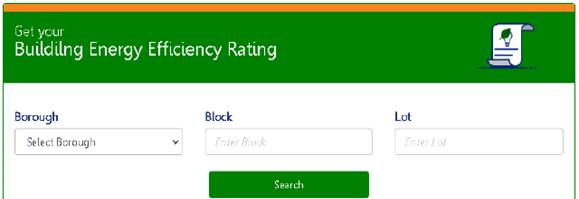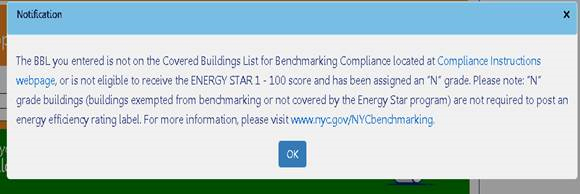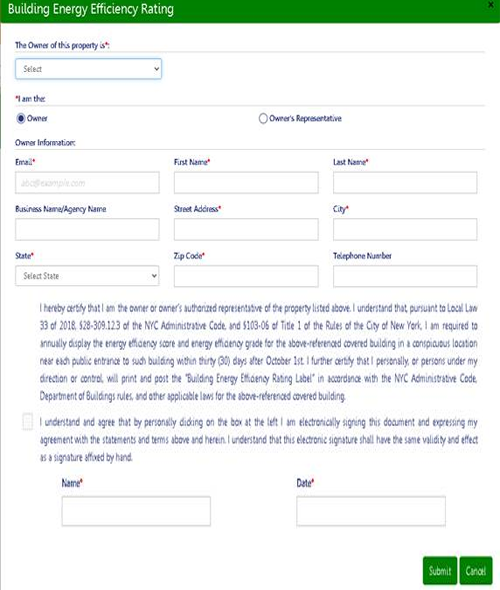
 Buildings311
Buildings311 Search all NYC.gov websites
Search all NYC.gov websites
Compliance Instructions
Click a topic, or press the enter key on a topic, to reveal its answer.
Benchmarking
The annual benchmarking compliance process consist of the following steps, described in detail below:
Check the Covered Buildings List (CBL) for your property every year.
*Note: The Covered Buildings List is sorted by the property’s 10-digit borough, block and lot number (BBL). To find your building on the list, select Control F (CTRL + F) on your computer keyboard to open a search dialog box, and enter your property’s BBL.*
To find your property's BBL number, please review your latest property tax bill from the Department of Finance (DOF) by visiting the DOF Property Tax Bill search. Properties listed in the following Covered Buildings List are required to benchmark their 2023 calendar year energy and water consumption prior to May 1, 2024:
- Covered Buildings List for Benchmarking Compliance in 2024 (Excel)
- Covered Buildings List for Benchmarking Compliance in 2024 (PDF)
All properties on this list must submit energy consumption data to the City through a benchmarking report. If the property is marked as ‘Yes’ in the ‘Is this required to report automated water data from DEP?’ column, water consumption data will have to be requested from the Department of Environmental Protection (DEP) and must also be submitted in the report. To request a temporary exemption from reporting due to a demolition, a new building (NB) permit, or when a building has not yet obtained its first TCO, email sustainability@buildings.nyc.gov.
A property's status can change from year to year, so be sure to review the newest Covered Buildings List (CBL) every year. A new CBL is made available every February. Property owners are also notified of a property's requirement to comply every November in their property tax bills prior to when the new CBL is posted online. If you are not receiving your property tax bills at the correct address, or your CBL address is incorrect, please update your address by visiting http://nyc.gov/changemailingaddress, or contact the Department of Finance (DOF) at sustainablebuildings@finance.nyc.gov. You can also see a property’s tax bill online.
Set up an account in ENERGY STAR Portfolio Manager® if you do not have one.
Enter or review building characteristics and uses.
If you are benchmarking a building for the first time, you must first enter characteristics of the building (size, completion status, year built, etc.) and primary and secondary (when applicable) building uses into Portfolio Manager®. You may find it helpful to create and fill out a data collection worksheet (opens in new window) first, to help you do the necessary research before you enter the data into Portfolio Manager®.
How to set up your property in Energy Star Portfolio Manager.
If an account was previously created, review the use details and update them to reflect how the building is currently being used.
Buildings with a Single/Primary Property Use
For buildings with a single/primary property use, other or any variation of other will no longer be acceptable as a valid primary property type. Please email sustainability@buildings.nyc.gov if you experience difficulty matching the building use to one of the property types listed in Portfolio Manager. All data entry related to property usage is subject to audit by the Department.
Buildings with Separate Property Uses
For buildings with separate property uses, follow the guidelines of the Portfolio Manager tool for reporting of mixed-use buildings. Refer to the Property Uses section in the ENERGY STAR Buildings FAQ for detailed instructions.
To complete this and subsequent steps, you are strongly encouraged to study the training materials to become familiar with Portfolio Manager®. The U.S. Environmental Protection Agency (EPA) offers a range of courses and webinars available at https://www.energystar.gov/buildings/training/ that will train you in how to use Portfolio Manager®.
Collect whole building energy data (and water data, if required) from utilities.
To benchmark a building please ensure that the entire building’s energy and water (if applicable) consumption is reported in one submission under the BBL number that is listed on the CBL.
To obtain whole building energy consumption data for benchmarking, you will need to obtain tenant consumption data in addition to base building data. Request whole building energy consumption data directly from the utilities. Visit the Energy and Water Data page for more information.
If you are required to benchmark your water use and you have not previously shared your property with the DEP to collect the water data, follow these instructions.
If your building uses fuel oil or other energy that is NOT provided by Con Edison or National Grid, create meters under the ‘Energy’ tab as needed. Then, enter energy use data into Portfolio Manager manually, by uploading a spreadsheet.
Confirm and enter BBL and BIN information (mandatory fields).
Check that your property's BBL on your Property Tax Bill matches to the BBL on the CBL. Go to the DOB Buildings Information System (BIS) to access your property’s profile.
- In the ‘Search by Property’ section enter your property's BBL number from the CBL and hit ‘GO’:

- Look at the top right corner of the Property Profile Overview to find your building Block, Lot and BIN information. Make sure to correctly copy and keep this information for your records. These numbers will be needed to enter your BBL and BIN information into Portfolio Manager® in the 10-digit BBL and 7-digit BIN format described below.
Note: Failure to accurately input the correct BBL and BIN information may result in a violation.
Enter your Property BBL
In Portfolio Manager®, click on the ‘Details’ tab, locate the ‘Unique Identifiers (IDs)’ section, and click on the ’Edit’ button. Navigate down to the ‘Standard IDs’ section. Select the ‘NYC Borough, Block and Lot (BBL)’ field from the pick list and enter the BBL in the form N-BBBBB-LLLL, using the ‘Block’ and ‘Lot’ information you obtained from the DOB website, where:
- N is your property's borough represented by a number. Borough numbers are as follows:
Manhattan = 1, Bronx = 2, Brooklyn = 3, Queens = 4, Staten Island = 5
- BBBBB ;is the 5-digit Block number with additional leading zeros entered to the left as needed
Example: ‘Block: 845’ = 00845
- LLLL is the 4-digit Lot number with additional leading zeros entered to the left as needed
Example: ‘Lot: 27’ = 0027
BBL Example: A correct BBL entry for a building in Queens, with ‘Block: 234,’ and ‘Lot: 56,’ would be entered in the ‘NYC Borough, Block and Lot (BBL)’ field as: 4-00234-0056.
Note: When entering a multi-building property as a campus, it is necessary to enter multiple BBLs in the Parent property. Multiple BBLs should be entered in the field separated by a semi-colon (;) without spaces.
Example: 4-00234-0056;4-00234-0057;4-00234-0058
Enter your property's BIN
Once you have entered your BBL, click on ‘Add another,’ locate the ‘NYC Building Identification Number (BIN)’ field in the ‘Standard IDs’ and enter your building 7-digit BIN number.
Note: For BBLs with multiple BINs, each BIN must be entered in the same field separated by a semi-colon (;) without spaces.
Example: 1234567;2345678;3456789
Check your data for errors and completeness.
- Check all energy and water consumption data for your property.
- Check that energy consumption data for the entire year (January 1 - December 31, inclusive) has been entered for each meter associated with the property.
- If you are required to benchmark your water usage, check that DEP has uploaded water consumption data for the entire year (January 1 - December 31, inclusive).
- Use the Portfolio Manager® Error Checker.
- Check your submitted data by clicking the ‘Check for Possible Errors’ button on the ‘Summary’ tab of each of your properties. Review and resolve all alerts.
- Review your account for common errors.
- Make sure that your Energy Use Intensity (EUI) data is realistic; and is no lower than 5 kBtu/sq ft or greater than 1,000 kBtu/sq ft.
- Check the basic information and property uses in the "Details" tab for each building of a property to be sure that gross floor area for the building is not zero, and floor areas for all property uses add up to the total gross floor area.
If you do not know how to correct your errors, please contact the NYC Sustainability Help Center at HELP@NYCsustainability.org or (212) 566-5584, Monday through Friday from 9:00 am to 5:00 pm.
Submit usage data to the City by May 1 through Portfolio Manager®
Before submitting your report, please review the Benchmarking Checklist to ensure that you have completed all the necessary steps. The benchmarking deadline for 2023 calendar year data reporting is May 1st, 2024.
To complete the benchmarking process, the City's reporting template must be uploaded into Portfolio Manager® and submitted to the City. Click on the Submission Instructions link below for directions on how to submit your data. If you are already familiar with the submission instructions, click on the reporting template link below to send the benchmarking report.
Once you complete the submission process, you should receive the Energy Star confirmation email (Data Release Receipt) with attached excel spreadsheet confirming your submission. If you receive an error message(s) from sustainability@buildings.nyc.gov following your submission, make sure to correct the errors as per email(s) sent to you and resubmit your report to the City.
Please retain the Energy Star confirmation email for a minimum of 3 years as proof of your submission.
How to Submit usage data to the City by May 1 through Portfolio Manager®
The NYC Sustainability Help Center is the one-stop-shop for information, assistance, and answers to your questions about the benchmarking process. Trained staff will walk you through benchmarking steps, directly provide or point you to training and informational resources, and help you resolve problems so that you can meet the May 1 deadline with time to spare. You can send your questions to Help@NYCsustainability.org, or call (212) 566-5584.
Other Benchmarking Links
Energy Efficiency Grading
Owners of properties required to benchmark their energy and water consumption annually prior to May 1 also must obtain and display a Building Energy Efficiency Rating label (if eligible*).
* N grade buildings (buildings exempted from benchmarking or not covered by the Energy Star program) are not subject to the posting requirement.
Beginning October 1, 2020, owners can access and print the label through a new Building Energy Efficiency Rating tab in the DOB NOW Public Portal at www.nyc.gov/dobnow. Please review details from the Service Notice.
ENERGY STAR 1-100 score eligibility:
- Barracks
- Data center
- Hospital (general medical and surgical) (eligible to receive the ENERGY STAR 1-100 score at the campus level)
- Hotel (eligible to receive the ENERGY STAR 1-100 score at the campus level)
- K-12 school (eligible to receive the ENERGY STAR 1-100 score at the campus level)
- Medical office
- Multifamily housing (eligible to receive the ENERGY STAR 1-100 score at the campus level)
- Office (covers office, bank branch, financial office, and courthouse)
- Residence hall/ dormitory
- Retail store (covers retail and wholesale club/supercenter)
- Senior care community (eligible to receive the ENERGY STAR 1-100 score at the campus level)
- Supermarket/grocery store
- Warehouse (covers distribution center, non-refrigerated warehouse, and refrigerated warehouse)
- Wastewater treatment plant
- Worship facility
Buildings exempted from benchmarking or not covered by the Energy Star program
- Multifamily buildings with less than 20 units, enclosed parking, or other property types that are not eligible to receive a 1-100 ENERGY STAR Score
- Some mixed-use buildings; a multi‐use property can receive the ENERGY STAR Score, but these two conditions apply:
- seventy‐five percent (75%) of the property's Gross Floor Area (GFA) must be comprised of property types that are eligible for an ENERGY STAR Score; and,
- more than fifty percent (50%) of the GFA must be comprised of one eligible property type (excluding parking)
- Buildings that contain a data center, television studio, and/or trading floor that together exceed ten percent of the GFA
Note: Properties with New Built or Demolition permits and no TCO in a reporting year, or properties with the ownership change in a reporting year may be eligible for a temporary exemption. To request such exemption email to sustainability@buildings.nyc.gov.
The Building Energy Efficiency Rating label will be made available in the DOB NOW Public Portal upon October 1 of every year.
Multiple buildings on one lot will receive one campus grade which is based on the score generated by the parent property if the benchmarking data was submitted as a campus and the property type is eligible to receive the ENERGY STAR 1-100 score at the campus level, or the same grade for each building on the lot if the benchmarking data was submitted aggregated across all buildings in one report as a standalone property. In both scenarios the assigned label will be generated for each building on the lot and must be printed by accessing each building’s property profile in the DOB NOW Public Portal and posted as required by Law. Multiple labels can be printed for buildings with more than one public entrance.
Retrieve the Building Energy Efficiency Rating label by visiting DOB NOW Public Portal and following these steps:
- Look for a new tab Building Energy Efficiency Rating on the DOB NOW Public Portal, under the Stop Work Orders Search tab:

NOTE: If your building generated a score in the ESPM, but you are receiving an error message in the DOB NOW and can’t access the label, please reach out to sustainability@buildings.nyc.gov for assistance before October 31.
- Search by Borough, Block and Lot (all required fields). Don’t enter any leading zeroes in the block and lot numbers.
- If a lot number exists, a list of BINs with corresponding addresses will be listed in rows. If not, an error message will be displayed:

- A button/ link to download the label will be displayed next to each row with specific BIN/Address:

- Once a user clicks on one of the buttons/links, they will get to a new screen where they will have to enter their information and sign the attestations (by checking a box):

- Once the user clicks submit, the label will be displayed and available for downloading and printing.
You may also find the How to Obtain your Building Energy Efficiency Rating video helpful.
Display printed label(s) in a conspicuous location near each public entrance within 30 days after October 1 of every year:
- The Building Energy Efficiency Rating label is designed to be accessible to all building owners and requires minimal cost to comply. A printed 8½” x 11” paper label is acceptable.
- Framing/laminating the label is suggested, but not required, as long as all information included in the label is clearly visible for the entire year.
- The label may be printed in color (recommended) or in gray scale.
- Once printed, the label shall be displayed either externally or internally in a conspicuous location near each public entrance, so it is visible to public.
- The label shall be displayed at a vertical height no less than four feet and no more than six feet from the ground or floor.
- The label shall not be defaced, marred, camouflaged or hidden from public view.
- The label must be replaced every year with the latest issued version and must be displayed year- round.

